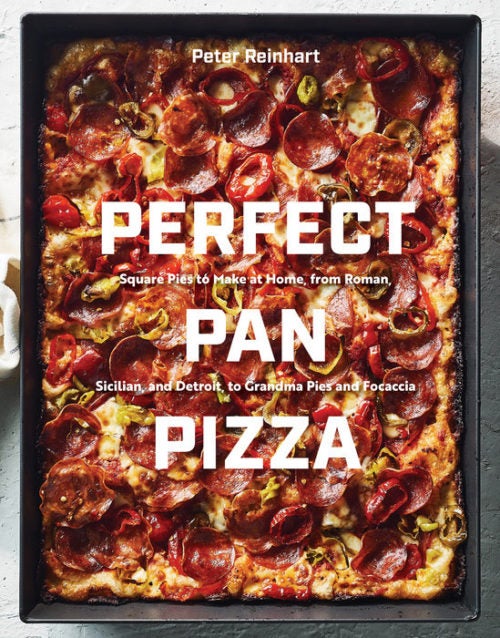




















Umberto’s, in New Hyde Park, Queens, is famous for this style of pizza (as is another place in Queens called, confusingly, Prince Umberto’s), but these sheet-pan pizzas have been made under various names for many years in many cities. The main difference between a Grandma and a Sicilian-style pizza, at least by some definitions, is that the Grandma pie is baked just once, with all the toppings on board, and not par-baked and then topped. This does create some challenges, such as getting the crust to finish baking at the same time as the toppings, so this is accomplished by first layering sliced, not grated, mozzarella cheese over the surface, not overloading the pizza with too much sauce, and baking at a slightly lower temperature and on a lower shelf in the oven, where the undercrust can bake before the cheese gets too well done. As always, it comes down to a balancing act between time, temperature, and ingredients.
NOTE: You can always add pepperoni or other toppings to this pizza, as you would for the Sicilian-style pizza. If not using fresh mozzarella, increase the grated mozzarella to 4 cups.
Directions
- In the bowl of a stand mixer fitted with the paddle attachment, or in a large mixing bowl, combine the flour, salt, and yeast. Add all of the water and mix on slow speed for 30 seconds or stir with a large spoon to form a coarse, shaggy dough. Add the 2 tablespoons of oil, increase the speed to medium (or continue mixing with the spoon or with wet hands), and mix for another 30 to 60 seconds to make a wet, coarse, sticky dough. It may seem too wet to form a cohesive dough at this stage. Let the dough rest for 5 minutes to fully hydrate.
- Increase the mixer speed to medium-high (or continue mixing by hand) and mix for another 30 to 60 seconds to make a smooth, sticky dough. It should be soft, supple, and sticky to the touch, and offer a little resistance when pressed with a wet finger.
- Use 1 teaspoon of the extra oil to make a 15-inch-diameter oil slick on the work surface. Rub some oil on a plastic bowl scraper and on your hands and use the scraper to transfer the dough to the oil slick. Flatten the dough with oiled hands. Use a plastic scraper, or your hands, and lift one end of the dough, folding it to the center. Lift the opposite end and flip it over the folded end. Fold the two wide ends in the same manner, to make the dough into a loose ball, and flip the dough over so that the smooth side is up. Cover the dough with a bowl and let it rest for 2 to 5 minutes. Repeat the stretch and fold (rub more oil on the work surface as needed), cover the dough, and let it rest for 2 to 5 minutes. Then repeat the stretch and fold, cover with the bowl, and again let it rest for 2 to 5 minutes. Perform a fourth and final stretch and fold to make a smooth ball of dough. The dough will have firmed up after each stretch and fold and will now be soft, smooth, supple, and somewhat sticky but firm enough to hold together when lifted. Transfer the dough to a lightly oiled bowl, cover with plastic wrap, and refrigerate for 12 to 72 hours.
- In a large bowl, stir together the tomatoes, pepper, basil, oregano, garlic, vinegar or lemon juice, and ½ teaspoon of the salt, adding the salt gradually and tasting as you go. Add more vinegar or lemon juice and salt, if needed. But be careful; the flavors of the herbs, garlic, and salt will intensify when the pizza is baked, so resist the urge to increase the amount. You can always add more herbs and salt on top of the pizza after it comes out of the oven.
- Transfer to a covered container, seal tightly, and refrigerate up to 10 days or freeze up to 3 months.
- At least 3 hours before you plan to bake the pizza, oil a 12 by 17-inch sheet pan, including the interior sides, with 4 tablespoons of the oil (you can use a pan liner, but it is not required). Place the dough in the center of the oiled pan. Rub the surface of the dough with olive oil and use your fingertips to begin dimpling and expanding it in all directions.
- Cover the pan loosely with plastic wrap and let the dough relax at room temperature for approximately 20 minutes.
- At 20-minute intervals, dimple from the center, with fingers angled toward the edges and corners. Each successive dimpling will expand the coverage over more of the pan.
- After three to four rounds of dimpling and resting, the dough will have relaxed enough to cover the whole pan. At this point, coat the top with the remaining 1 tablespoon of oil and sprinkle with the garlic. Cover the pan with plastic wrap and let it rest for 2 to 2 ½ hours at room temperature.
- Twenty minutes before baking the pizza, preheat the oven to 450°F (425°F for convection). Remove the plastic wrap and lay the sliced mozzarella cheese over the surface, covering it as completely as possible. Ladle and spread the sauce over the cheese. If using, tear or cut the fresh mozzarella into 8 to 10 pieces and space them evenly over the sauce.
- Bake on a shelf in the lower third of the oven for 8 minutes. Then rotate the pan 180 degrees and continue baking 8 to 12 minutes longer, or until the cheese is bubbly and caramelized and the undercrust is brown and crisp. Remove the pan from the oven and sprinkle the pizza with the grated Parmesan or other dried cheese. Return the pizza to the oven for 1 minute to slightly melt the cheese.
- Transfer the baked pizza to the stovetop or to a heatproof counter and let it rest for 2 minutes. Using an offset spatula or bench blade, carefully slide it around the edge, between the crust and the side of the pan, and then lift the pizza out of the pan and slide it onto a cutting board. Sprinkle the pizza with oregano, then cut into 3-or 4-inch squares and serve. (Note: You can also cut the pizza directly in the pan if it is too difficult to remove, but be careful not to cut into the metal of the pan.)
Reprinted with permission from Perfect Pan Pizza by Peter Reinhart, copyright © 2019. Published by Ten Speed Press, an imprint of Penguin Random House. Photography copyright Johnny Autry.

